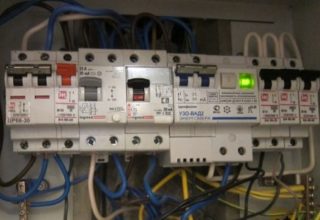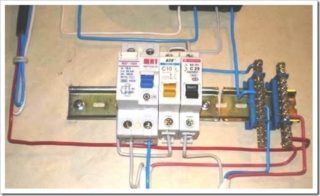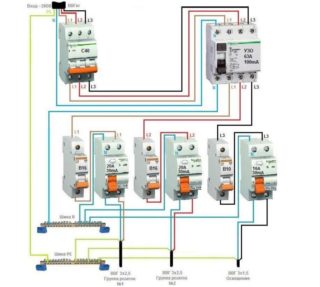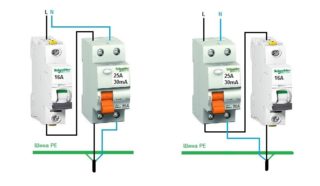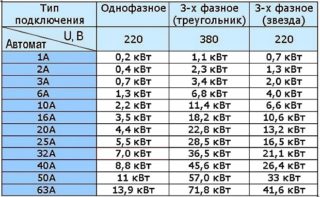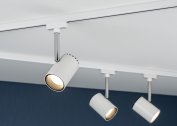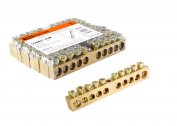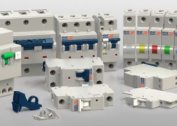When installing a new or upgrading an old shield with a new machine, it is necessary to install a protective circuit breaker. The device protects the line from overloads, short circuits and prevents the failure of household appliances. Some masters cannot decide whether to put an RCD before the machine or after. Popular circuits will help you choose a connection method.
The principle of operation of the RCD, differences from the difavtomat
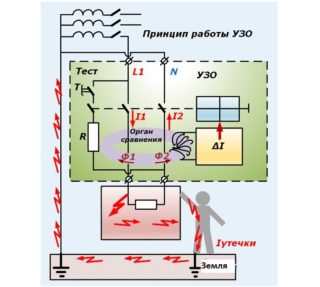 PUE requirements indicate the need for the installation of protective equipment. It provides protection against electric shock, breakdowns of the cable insulation coating. RCD can be connected to 2 wires in a network with a voltage of 220 V and 4 wires in a network to 380 V.
PUE requirements indicate the need for the installation of protective equipment. It provides protection against electric shock, breakdowns of the cable insulation coating. RCD can be connected to 2 wires in a network with a voltage of 220 V and 4 wires in a network to 380 V.
The disadvantage of this device is the inability to determine overload or short circuit. An automatic switch will further protect it. The difference between the devices is the RCD response to the current imbalance of phase and zero with a nominal value of 10-30 mA. The device does not recognize overcurrents and may even catch fire under their influence.
Difavtomat normally works with a current strength of up to 16 A, turns off the line in case of leaks. Unlike RCD, it has a time-current characteristic, on which the speed of shutdown depends.
The circuit breaker with an electromagnetic release trips when the current value is exceeded 5-10 times.
Features of the integrated operation of protective devices
To understand how to put an RCD - after or before the machine, you need to understand the functionality of the installation. A good example would be a system of a metering device, a residual current device, a difavtomat, tossed on one line.
The voltage from the transformer will pass through the RCD and the meter, supplied to the outlets. If there is no protection, the trip device burns out. The absence of a trip in front of the meter will also lead to a fire in the line. The best option is a protective device on both sides.
According to the requirements of the PUE, bipolar modifications of automatic machines are put to the accounting device. It is not necessary to put it in front of him - it is better to protect the line from the RCD to consumers.
Installing an RCD before or after the machine
The device responsible for disconnecting the line does not respond to overcurrents, therefore, it does not work with short circuits and overloads. Sharing with a difavtomat will warn you of these situations.
Since the fault current exceeds the rated current, the internal components of the device are damaged, the contacts burn out. Models without built-in protective elements must be installed together with automatic devices that eliminate the effects of overloads and short circuits. In this case, the current of the circuit breaker should not exceed the current rating of the RCD. For example, the latter responds to 40 A. The optimal switch for it is 36 A.
RCD connection diagrams with a switch
Protective equipment must be connected to two cables. According to the first, the load current will go; according to the second, it will be directed to the external circuit from consumers. In order not to hesitate, RCDs are placed before the machine or after, you should use popular schemes.
For several groups of difavtomats - one RCD
Clause 7.1.79 of the EMP allows you to organize the protection of several lines using RCDs. The device must be placed on top, then the circuit breakers for consumer groups. In case of short circuits, the current passes through the RCD to the group circuit breaker, then to the power cable and to the consumer. If the rating of the devices is selected correctly, not one of them will be damaged.
The advantages of implementing the scheme include saving finances and space in the distribution panel. Connection minus - disconnection of all groups after RCD tripping.
RCD installation to the machine
The scheme provides for installation in the following sequence:
- Protective shutdown device.
- Difavtomat.
- Power wire.
- Consumer.
If there is damage, the short circuit current passes through the RCD until the circuit breaker stops.
RCD after the machine
System assembly is carried out according to the principle;
- switch - bipolar or feeder;
- counter;
- RCD
- machines depending on the number of lines.
This option is correct, because it is easy to understand how to turn off the machine and apply input to its terminals. Despite the fact that RCDs break more often, they are easier to replace.
At the time of a short circuit, current will pass from the switch to the RCD, then to the power cord, then to the consumer. The switch stops and the safety device remains intact.
To prevent overload between the meter and the RCD, you can put a second difavtomat.
Connecting an RCD to a group of machines
A similar circuit is assembled in a three-phase switchboard, where are:
- 3 three-phase difiltomat;
- three-phase RCD;
- 2 single-phase RCDs;
- 4 single-phase single-pole machines.
From the first input machine, the voltage will go to the second three-phase in the upper terminals. From the same device, one phase will go to a single-phase RCD, the second to the next.
Single-phase protection devices have two poles, difavtomaty - one. For the system to work without failures, you do not need to connect a working zero after it. For this reason, a zero bus must be installed after each protective device.
In the presence of two-pole machines, a separate zero bus is not set. When combining two zeros, a false positive is possible.
The first one-pole RCD is connected to differential machines No. 1 and No. 3, the second - to No. 2 and No. 4. A load is pulled onto the lower terminals.
The ground bus is common, but must be installed separately. Three phases with a working zero start up the input device. It connects to a common zero, and then it is allocated to all RCDs. After the device, No. 1 goes to a three-phase load, after the remaining single-phase, to each bus.
The wire on the PEN and PE is not separated - the ground, zero and 3 phases go to the shield.
Where to put an RCD
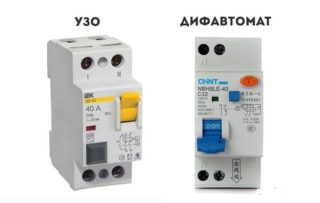 To determine where to install the circuit breaker, you need to remember the speed of current flow through the wires. It equals the speed of light - 300 thousand km / s. In a standard C 16 machine, the on-time during the passage of currents 5 × In (80 A) will be 0.02 sec. The distance he will cover is 6000 km.
To determine where to install the circuit breaker, you need to remember the speed of current flow through the wires. It equals the speed of light - 300 thousand km / s. In a standard C 16 machine, the on-time during the passage of currents 5 × In (80 A) will be 0.02 sec. The distance he will cover is 6000 km.
In the event of a short circuit, the current will completely pass through the coupler difavtomat - RCD - cable - socket. In this case, the switch does not work instantly, as a result of which the insulation is melted and the socket contacts burn up.
The RCD does not fail, because a short circuit is an inertial reaction. A time of 0.02 seconds is simply not enough to melt the insulation coating and damage parts. Even taking into account the disconnecting ability, the protective devices will work properly regardless of the installation location:
- Automatic - RCD. The phase is supplied with a jumper, and zero is directly to the protective device. The wire to the sockets is connected to the device and the PE bus.
- RCD - automatic. The wire connects to sockets through different paths. Phase goes to the machine, zero to the protection device or zero bus.
Thus, there is no difference where the RCD was installed - before or after the difavtomat.
Rating of the machine
The rated value is indicated on the case of any device - the value of the maximum continuous current that passes through the device without harm.This parameter is safe for current switching.
To ensure protection of the RCD itself, it is required to put a difavtomat with a rating similar to or 1 more than the rating of the device. If there is an automatic machine with a nominal value of 16 A, the RCD should be about 25 A. Such a current reserve will be enough to prevent the flow of energy when the load increases.
The machine is triggered when a current appears 13% higher than the rated value: a 16 A modification will work at a current of 18 A. If the RCD rating is equal, the contacts can heat up. To select the face value of a system with several difratomata, you need to summarize them and choose an RCD with a large indicator.
Nuances of installing a protective device
Connecting an RCD in an apartment or house requires compliance with several rules:
- For several groups of consumers you need to put one RCD and individual machines.
- If there are several RCDs, for each of them you will need a zero output bus.
- The TN-C system is not required to zero.
- For “wet groups”, a protective device with a trip rating of 10 mA is mandatory.
- 30 mA devices are suitable for water-powered household appliances.
- The zero terminal is located on the right of the device and is marked with the letter N. It must not be confused with the phase (index L).
- Input can be made to the lower or upper terminals.
- The classic circuit is implemented through the upper input and lower output.
- For each RCD, a personal zero block is needed, to which all working neutrals are brought.
- For a line with ripple currents, type A devices are needed.
You can check the health of the system by pressing the "Test" key.
The circuit breaker is needed to protect against overloads, short circuits. Due to the lack of reaction to overcurrents, it is established in combination with a difavtomat. Connection schemes allow the installation of devices in any order. The only condition is the choice of the appropriate face value.
